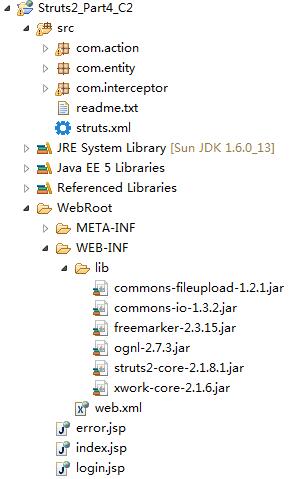6Struts2拦截器实现权限控制
Posted 红酒人生
tags:
篇首语:本文由小常识网(cha138.com)小编为大家整理,主要介绍了6Struts2拦截器实现权限控制相关的知识,希望对你有一定的参考价值。
1、创建如下项目结果

2、在com.entity包下创建

1 package com.entity; 2 3 public class User { 4 private String name; 5 private String pwd; 6 7 public User() { 8 } 9 10 public User(String name, String pwd) { 11 this.name = name; 12 this.pwd = pwd; 13 } 14 15 public String getName() { 16 return name; 17 } 18 19 public void setName(String name) { 20 this.name = name; 21 } 22 23 public String getPwd() { 24 return pwd; 25 } 26 27 public void setPwd(String pwd) { 28 this.pwd = pwd; 29 } 30 31 @Override 32 public String toString() { 33 return "User [name=" + name + ", pwd=" + pwd + "]"; 34 } 35 36 37 38 }
3、在com.action包下创建LoginAction.java

1 package com.action; 2 3 import javax.servlet.http.HttpSession; 4 5 import org.apache.struts2.ServletActionContext; 6 7 import com.entity.User; 8 import com.opensymphony.xwork2.ActionContext; 9 import com.opensymphony.xwork2.ActionSupport; 10 /** 11 * 登录的Action 12 * @author pc 13 * 14 */ 15 public class LoginAction extends ActionSupport { 16 private User user; 17 public String login(){ 18 HttpSession session=ServletActionContext.getRequest().getSession(); 19 20 //登录成功,将用户放入session作用域中 21 if(user!=null){ 22 System.out.println("user:"+user); 23 //保存用户信息到Session中 24 session.setAttribute("user", user); 25 return SUCCESS; 26 }else{ 27 return ERROR; 28 } 29 30 } 31 public User getUser() { 32 return user; 33 } 34 public void setUser(User user) { 35 this.user = user; 36 } 37 38 39 }
4、在com.interceptor包下创建LoginInteceptor.java

1 package com.interceptor; 2 3 import java.util.Map; 4 5 import javax.servlet.http.HttpSession; 6 7 import org.apache.struts2.ServletActionContext; 8 9 import com.entity.User; 10 import com.opensymphony.xwork2.Action; 11 import com.opensymphony.xwork2.ActionInvocation; 12 import com.opensymphony.xwork2.interceptor.AbstractInterceptor; 13 /** 14 * 权限验证检查拦截器 15 * @author pc 16 * 17 */ 18 public class LoginInteceptor extends AbstractInterceptor { 19 20 @Override 21 public String intercept(ActionInvocation invocation) throws Exception { 22 //Map<String, Object> session=invocation.getInvocationContext().getSession(); 23 HttpSession session=ServletActionContext.getRequest().getSession(); 24 User user=(User)session.getAttribute("user"); 25 System.out.println("loginInte:"+user); 26 27 if(user==null){ 28 //请求的Action 29 return invocation.invoke(); 30 }else{ 31 return Action.LOGIN; 32 33 } 34 } 35 36 }
5、在src下创建struts.xml文件

1 <?xml version="1.0" encoding="UTF-8"?> 2 <!DOCTYPE struts PUBLIC "-//Apache Software Foundation//DTD Struts Configuration 2.1//EN" "struts-2.1.dtd" > 3 <struts> 4 <!--1. 中文乱码处理 --> 5 <constant name="struts.i18n.encoding" value="UTF-8"/> 6 7 <package name="default" namespace="/" extends="struts-default"> 8 <!--2. 配置所有拦截器的节点 --> 9 <interceptors> 10 <!-- 定义权限验证拦截器 --> 11 <interceptor name="myLogin" class="com.interceptor.LoginInteceptor"></interceptor> 12 13 <!-- 定义拦截器栈 --> 14 <interceptor-stack name="myStack"> 15 16 <!-- 引用自定义拦截器 --> 17 <interceptor-ref name="myLogin"/> 18 19 <!-- 引用系统默认拦截器 --> 20 <interceptor-ref name="defaultStack"/> 21 </interceptor-stack> 22 </interceptors> 23 24 <!-- 3.定义默认拦截器 --> 25 <default-interceptor-ref name="myStack"/> 26 27 <!-- 4.定义全局结果 --> 28 <global-results> 29 <result name="login" type="redirect">/login.jsp</result> 30 </global-results> 31 <!-- 5.配置Action=明星 --> 32 <action name="login" class="com.action.LoginAction" method="login"> 33 <result name="success">/index.jsp</result> 34 <result name="error">/error.jsp</result> 35 <!-- 引用拦截器==小工 --> 36 <interceptor-ref name="myStack"/> 37 </action> 38 </package> 39 </struts>
6、在WebRoot下创建login.jsp文件

1 <%@ page language="java" import="java.util.*" pageEncoding="UTF-8"%> 2 <% 3 String path = request.getContextPath(); 4 String basePath = request.getScheme()+"://"+request.getServerName()+":"+request.getServerPort()+path+"/"; 5 %> 6 7 <!DOCTYPE html PUBLIC "-//W3C//DTD HTML 4.01 Transitional//EN"> 8 <html> 9 <head> 10 <base href="<%=basePath%>"> 11 12 <title>My JSP \'index.jsp\' starting page</title> 13 <meta http-equiv="pragma" content="no-cache"> 14 <meta http-equiv="cache-control" content="no-cache"> 15 <meta http-equiv="expires" content="0"> 16 <meta http-equiv="keywords" content="keyword1,keyword2,keyword3"> 17 <meta http-equiv="description" content="This is my page"> 18 <!-- 19 <link rel="stylesheet" type="text/css" href="styles.css"> 20 --> 21 </head> 22 23 <body> 24 <center> 25 <fieldset style="width:300px;"> 26 <legend>登录</legend> 27 <!-- 在浏览器直接请求页面,拦截器不会发生任何作用, 28 拦截器只针对于Action的请求发生作用 29 也就是login.action走拦截器,直接请求index.jsp不会走拦截器--> 30 <form action="login.action" method="post"> 31 <table> 32 <tr> 33 <td>用户名:</td> 34 <td><input type="text" name="user.name"/></td> 35 </tr> 36 <tr> 37 <td>密码:</td> 38 <td><input type="password" name="user.pwd"/></td> 39 </tr> 40 <tr> 41 <td><input type="submit" value="提交"/></td> 42 <td><input type="reset" value="重置"/></td> 43 </tr> 44 </table> 45 </form> 46 </fieldset> 47 </center> 48 </body> 49 </html>
7、在WebRoot下创建index.jsp文件

1 <%@ page language="java" import="java.util.*" pageEncoding="UTF-8"%> 2 <%@taglib uri="/struts-tags" prefix="s"%> 3 <% 4 String path = request.getContextPath(); 5 String basePath = request.getScheme()+"://"+request.getServerName()+":"+request.getServerPort()+path+"/"; 6 %> 7 8 <!DOCTYPE HTML PUBLIC "-//W3C//DTD HTML 4.01 Transitional//EN"> 9 <html> 10 <head> 11 <base href="<%=basePath%>"> 12 13 <title>My JSP \'index.jsp\' starting page</title> 14 <meta http-equiv="pragma" content="no-cache"> 15 <meta http-equiv="cache-control" content="no-cache"> 16 <meta http-equiv="expires" content="0"> 17 <meta http-equiv="keywords" content="keyword1,keyword2,keyword3"> 18 <meta http-equiv="description" content="This is my page"> 19 <!-- 20 <link rel="stylesheet" type="text/css" href="styles.css"> 21 --> 22 </head> 23 24 <body> 25 <h1>操作成功</h1> 26 <s:if test="user.name eq \'holly\'"> 27 holly你来啦? 28 </s:if> 29 <s:else> 30 我不认识你?你是谁? 31 </s:else> 32 </body> 33 </html>
8、在WebRoot下创建error.jsp文件

1 <%@ page language="java" import="java.util.*" pageEncoding="UTF-8"%> 2 <% 3 String path = request.getContextPath(); 4 String basePath = request.getScheme()+"://"+request.getServerName()+":"+request.getServerPort()+path+"/"; 5 %> 6 7 <!DOCTYPE HTML PUBLIC "-//W3C//DTD HTML 4.01 Transitional//EN"> 8 <html> 9 <head> 10 <base href
